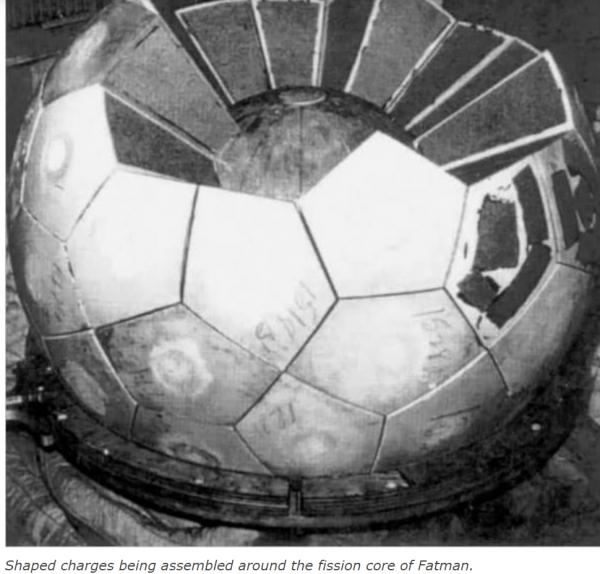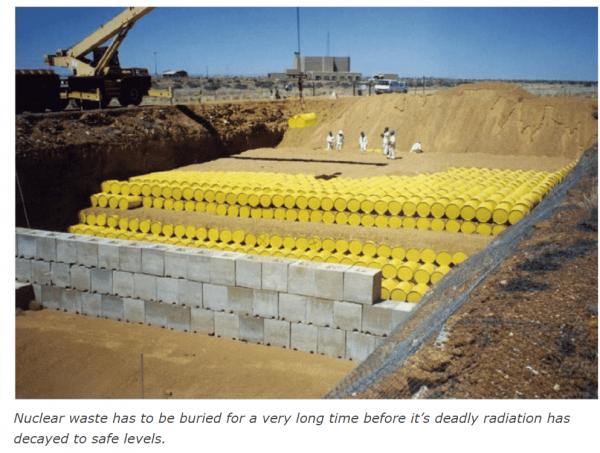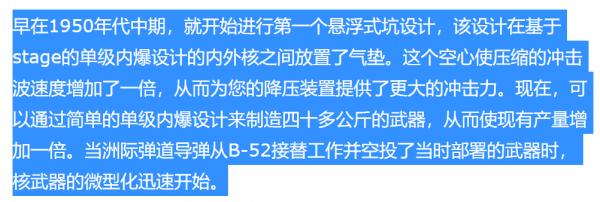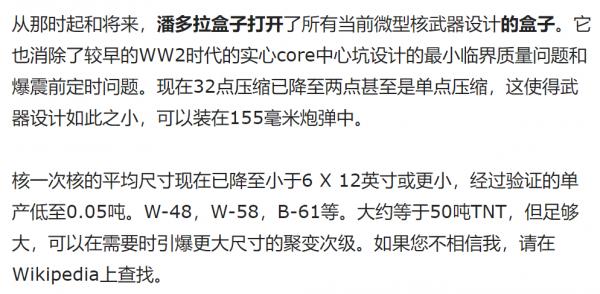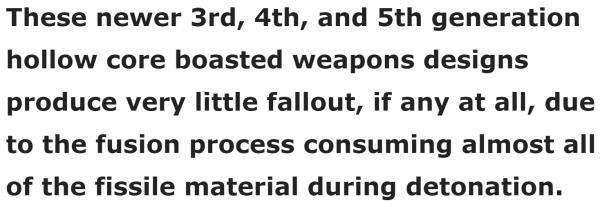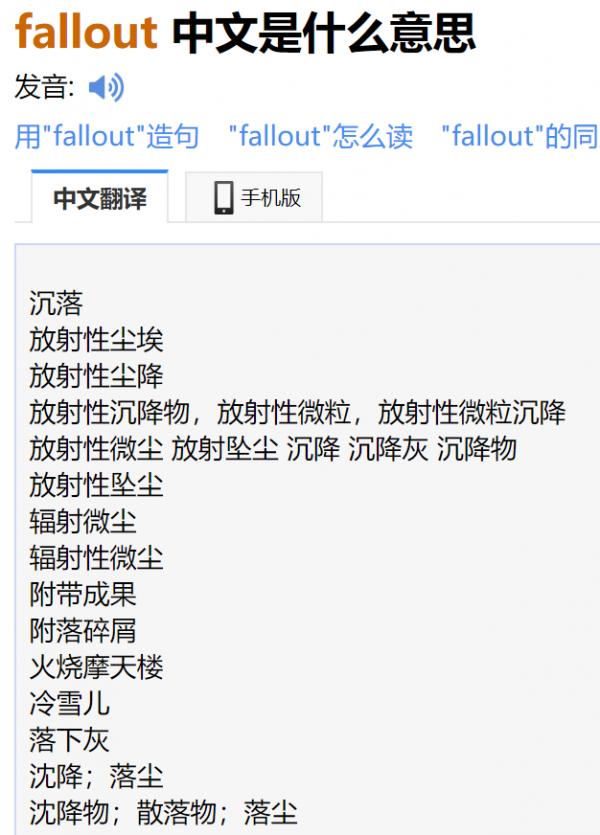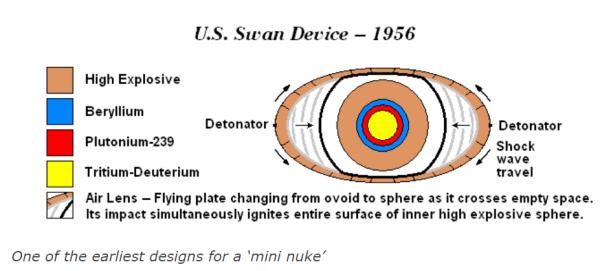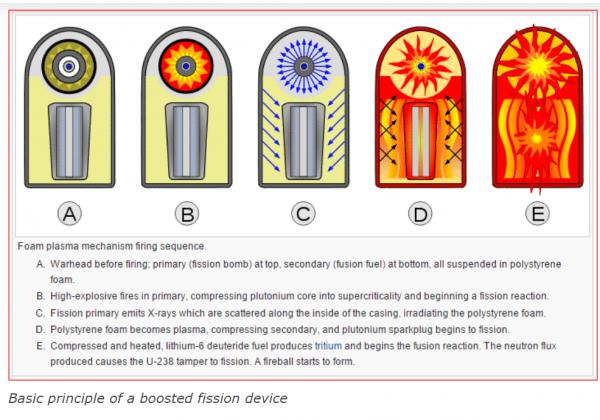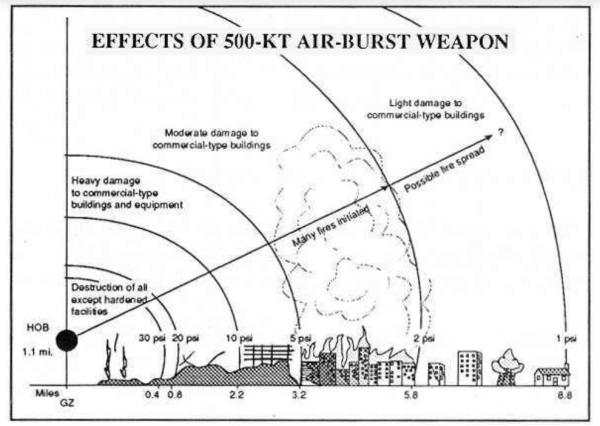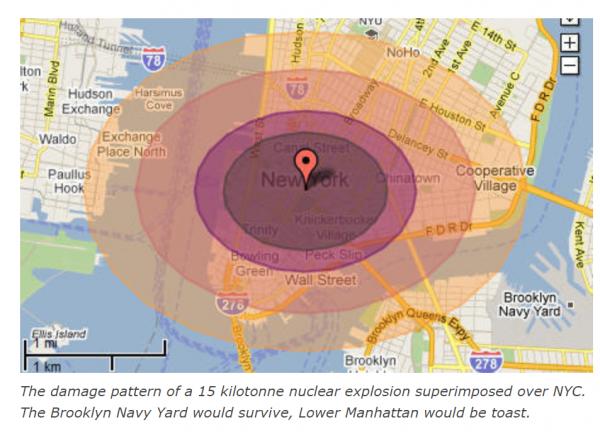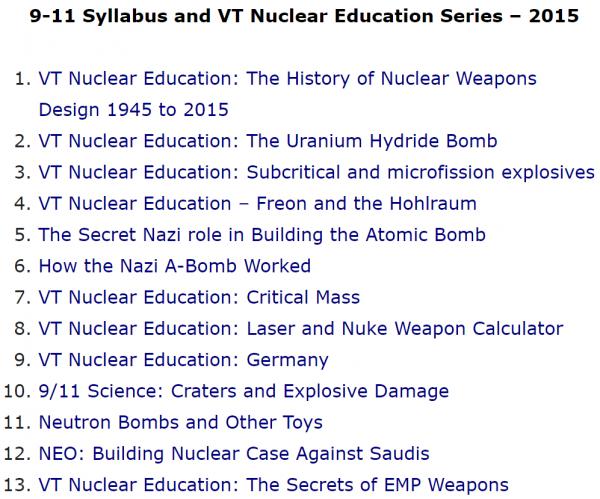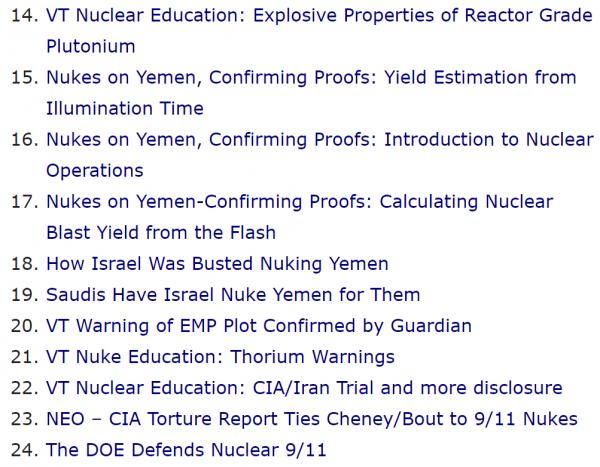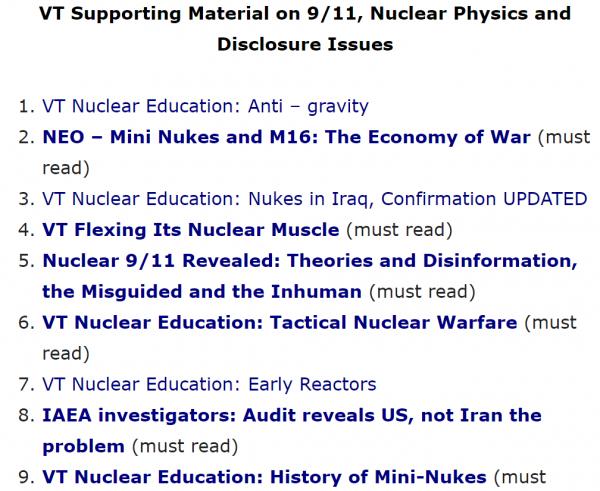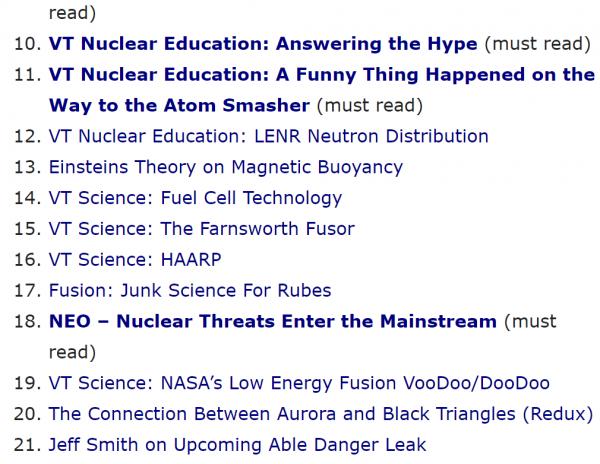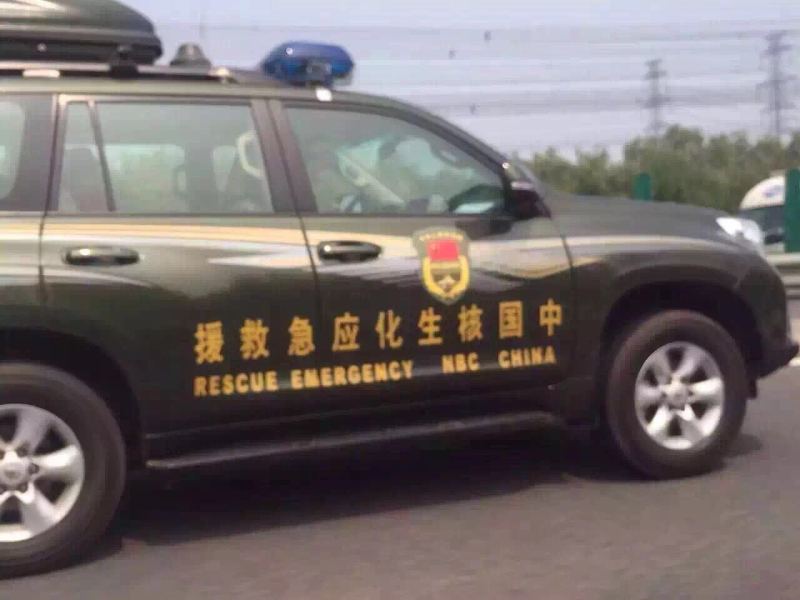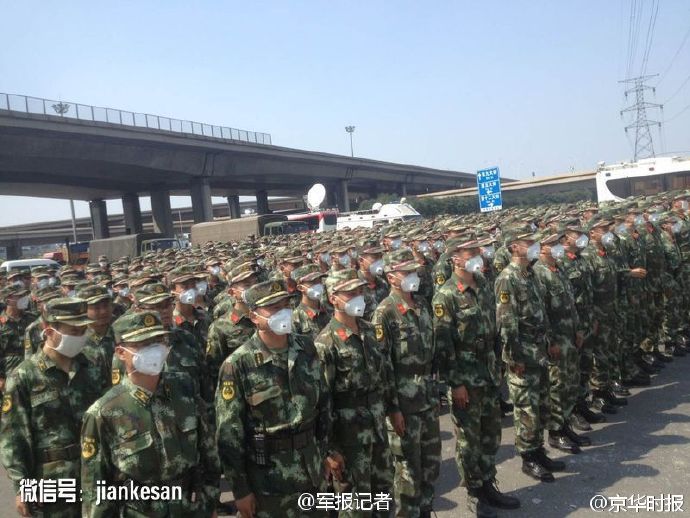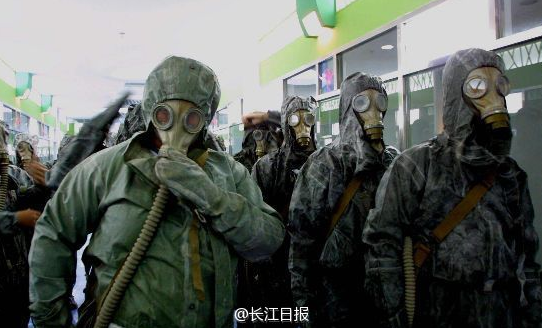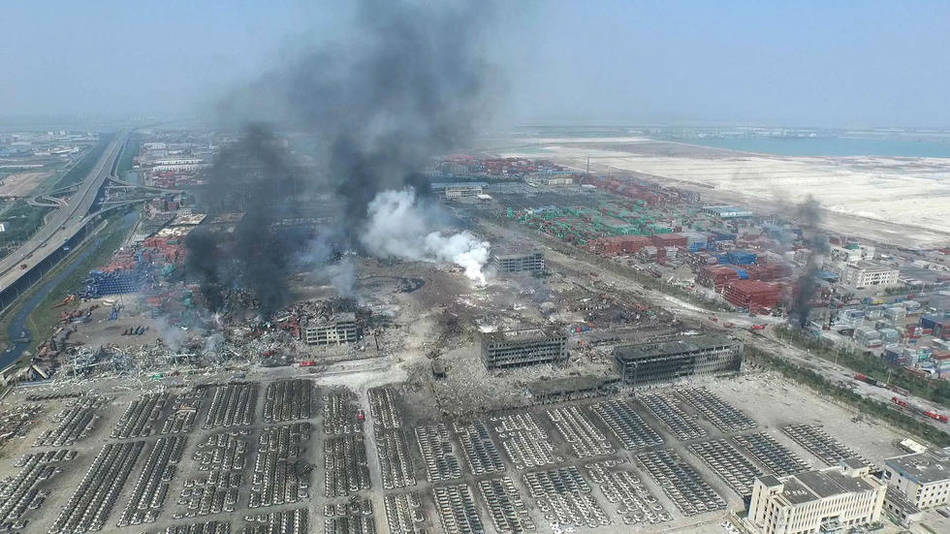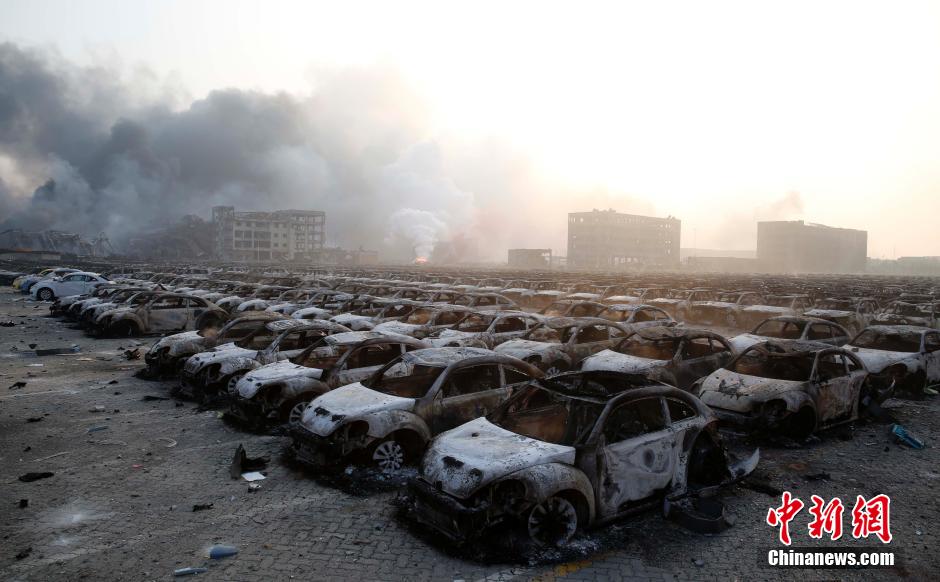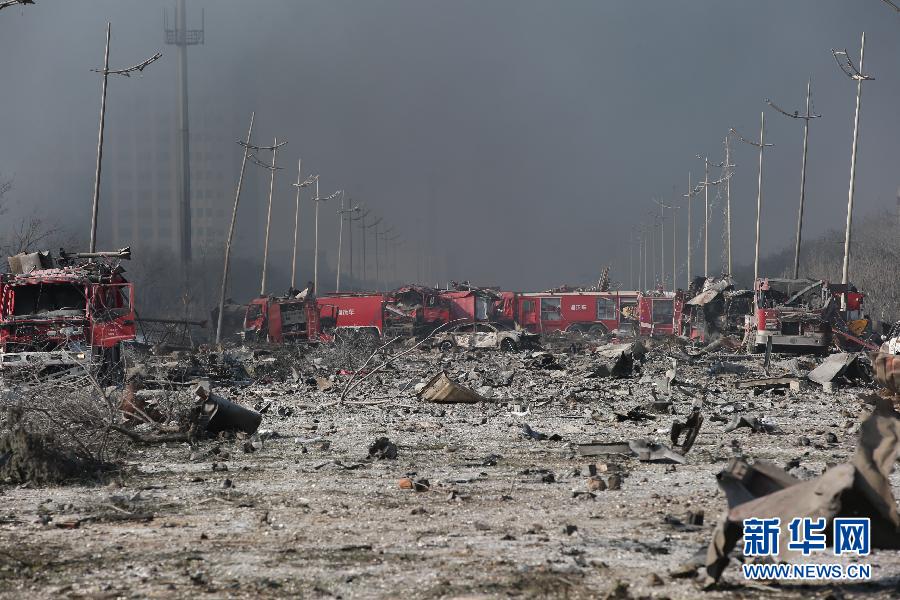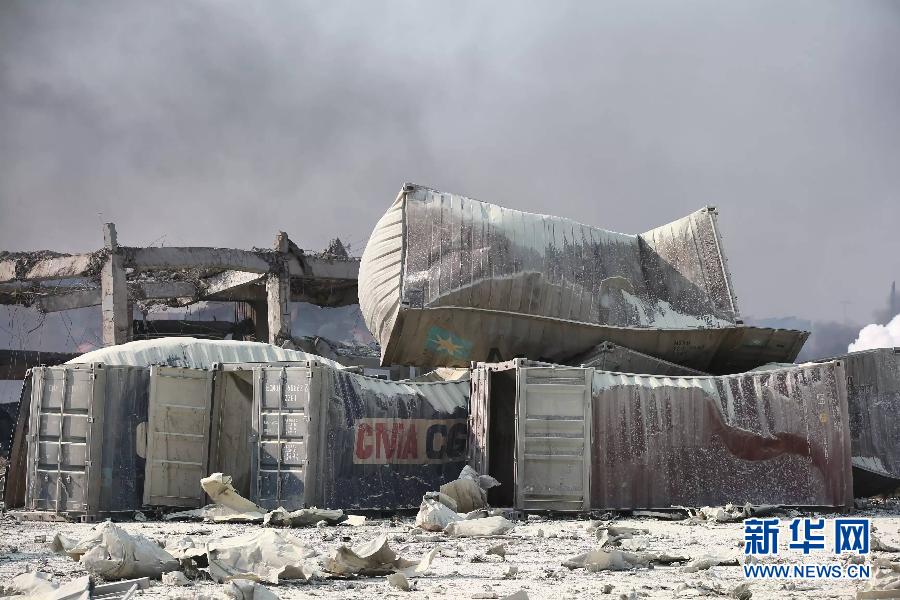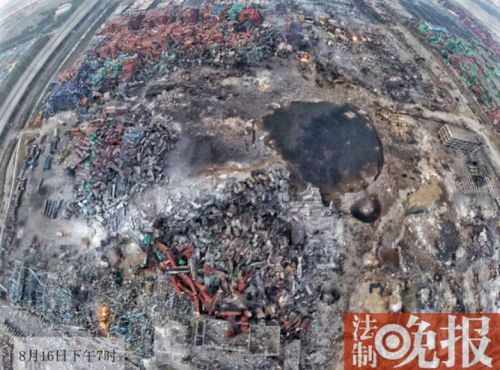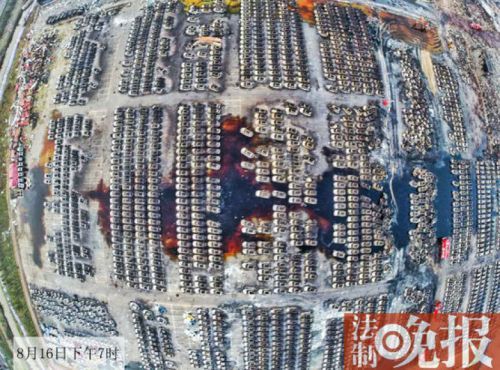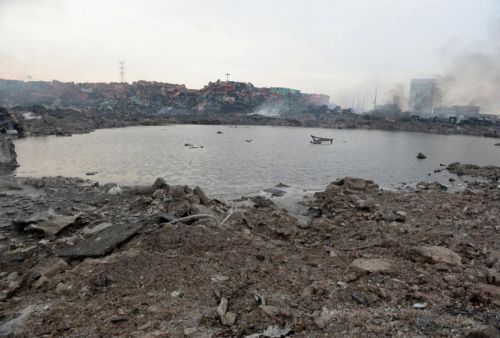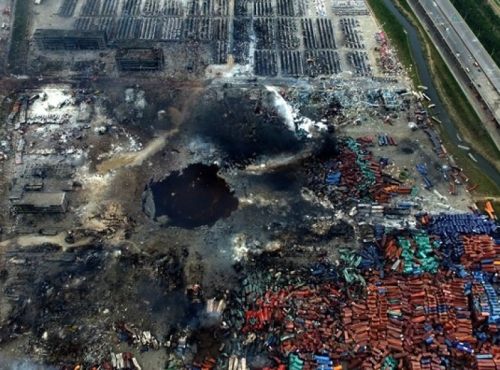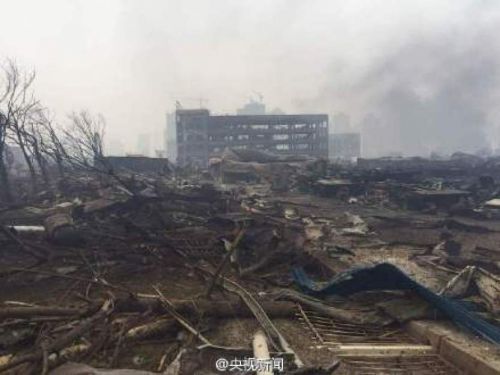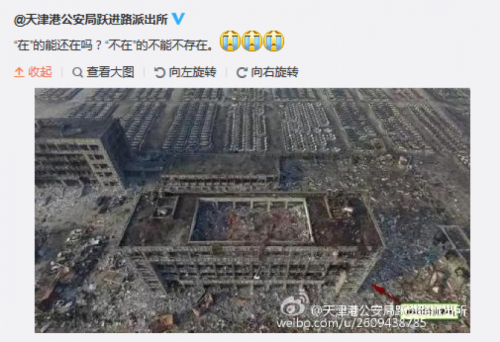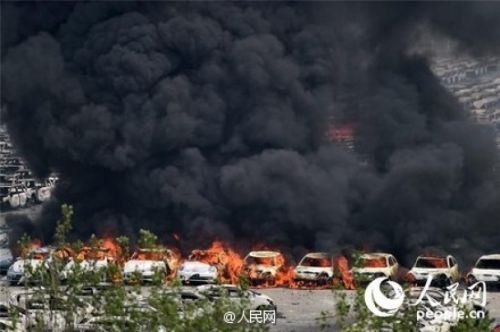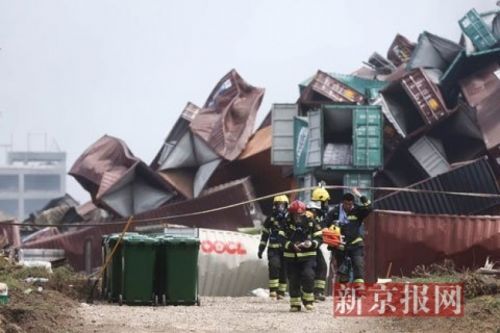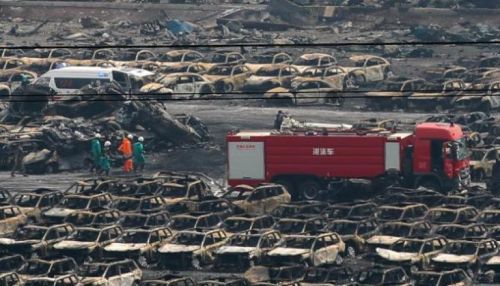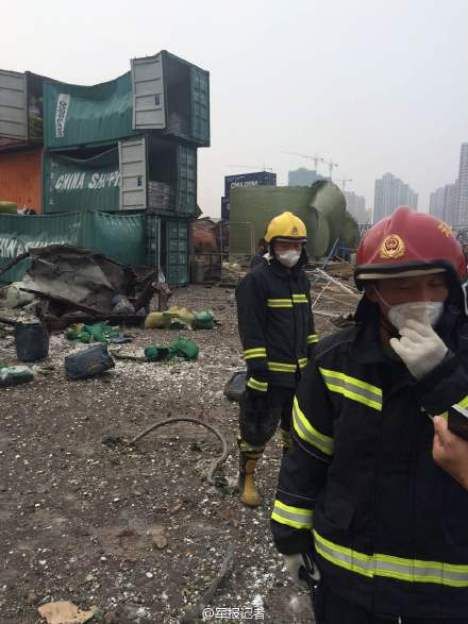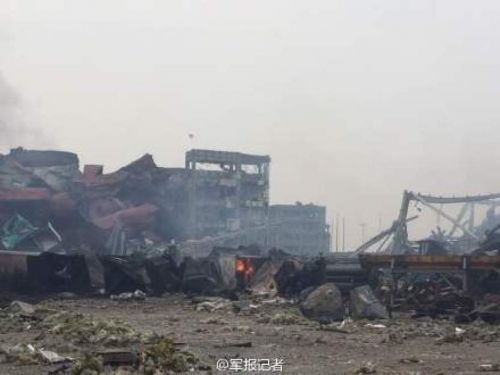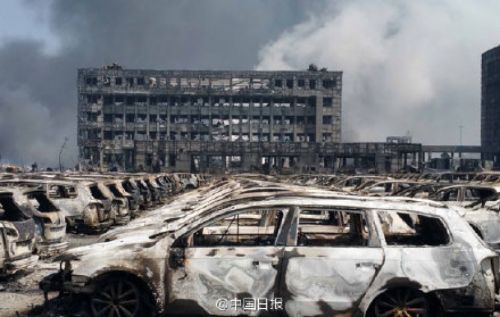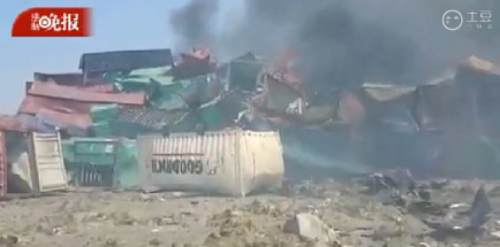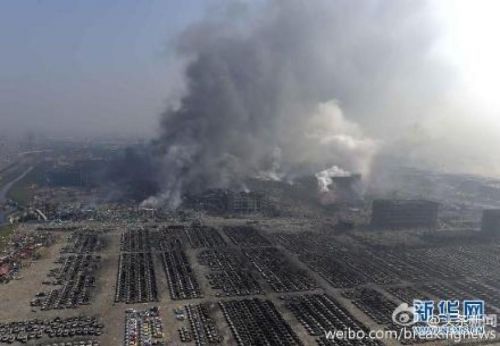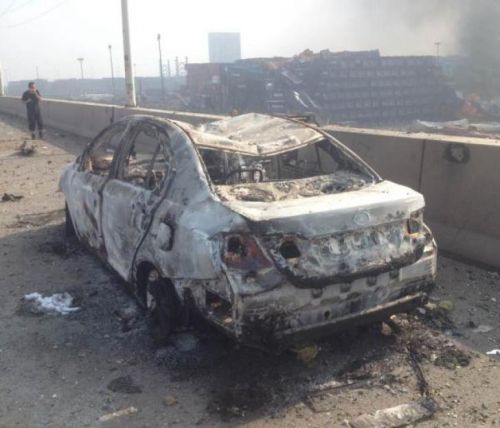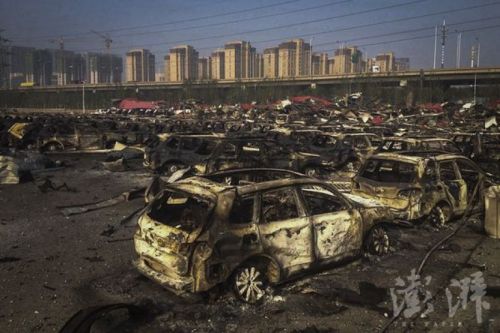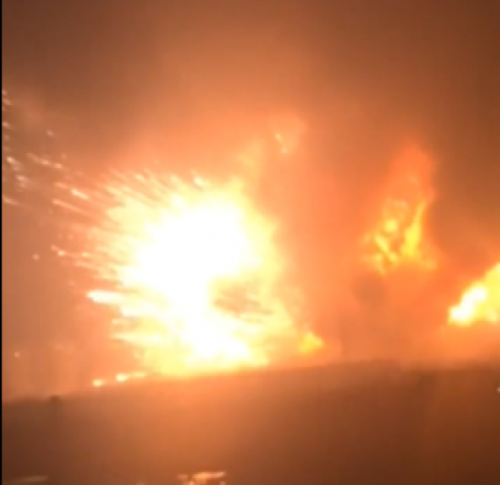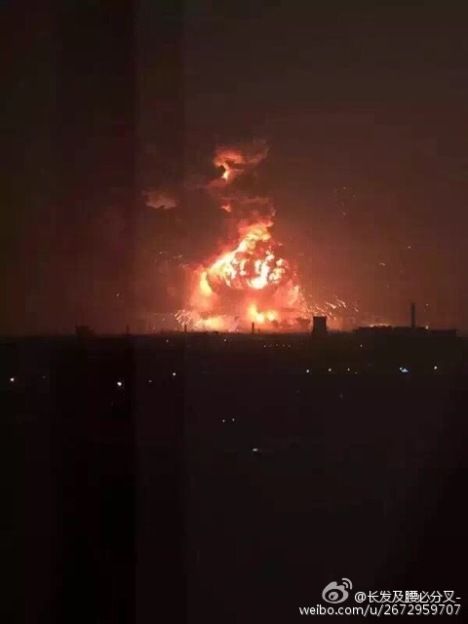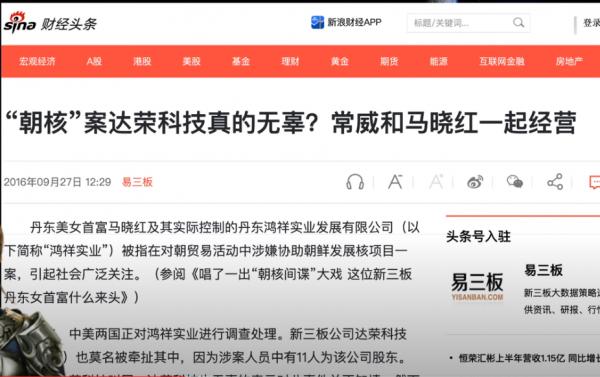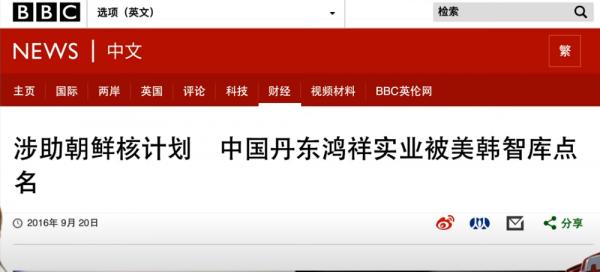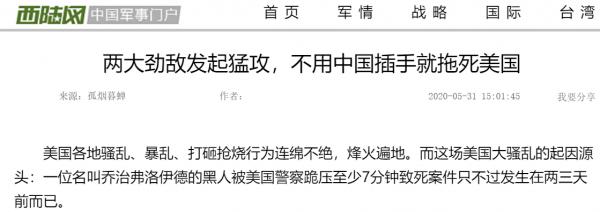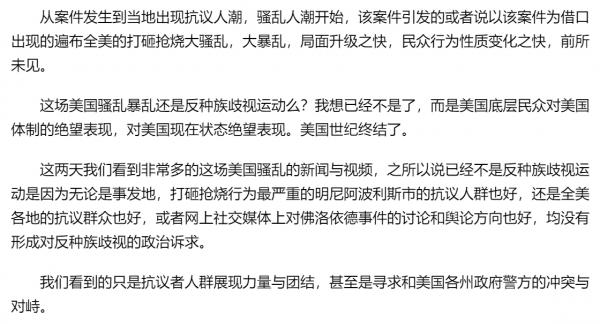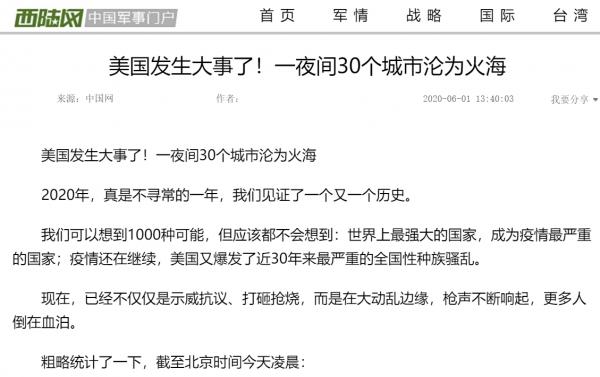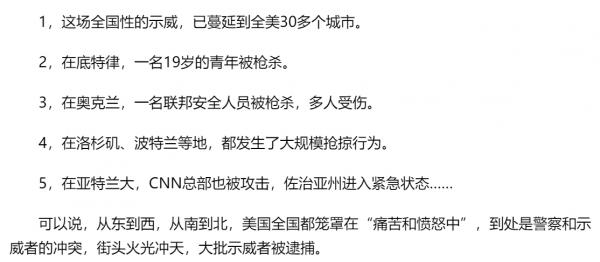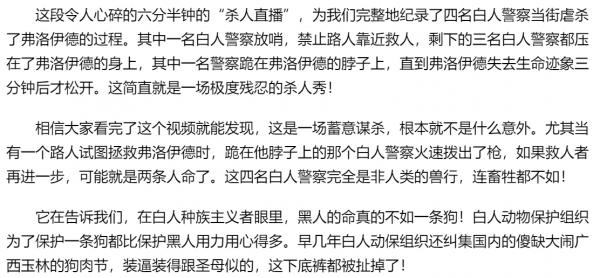| 你所有博文都是胡說中國哪來小型原子彈? |
| 送交者: Pascal 2020年06月01日13:20:49 於 [五 味 齋] 發送悄悄話 |
|
http://blog.creaders.net/u/8994/202005/375109.html
https://www.chinanews.com/gn/2019/05-12/8834204.shtml
In the last year we have covered a number of incidents where nuclear weapons have been used; from exposing the truth about the nuclear nature of the destruction of the WTC on 9-11 to being the only media outlet to cover the nuclear explosions in China. In the minds of most people, a nuclear weapon is a large device carried on the tip of an ICBM or carried in the belly of a huge bomber aircraft that when deployed produces a colossal explosion and spectacular mushroom cloud just like all those terrifying 1950s newsreels . However, this is no longer the case – nuclear weapon design is several generations in advance of the bulky devices of the Cold War and today, a wide variety of types of nuclear weapon exist and they come in all sizes from the smallest ‘micro nukes’ with yields measuring in hundreds of tonnes of TNT equivalent up to truly monstrous two and three stage bombs with yields of many millions of tonnes of TNT (megatonnes). The megatonne class bombs have never been deployed in anger; if they had, there would be no possible way to keep it a secret – the devastation and fallout would be on such a grand scale as to be impossible to hide. However, the sub-kilotonne mini and micro nukes have been used many times, both in false flag ‘terrorist’ attacks like 9-11 and OK City and in military conflicts in countries such as Iraq, Syria and Yemen. The small yield and limited destruction of these mini and micro nukes means it is possible to keep their use secret; especially when the media are compliant and willfully ignore any and all instances of their use. The willingness of several players to use these diabolical weapons should send a chill down the spine of every sensible person – we are living in a new nuclear age far more dangerous and deadly than the previous Cold War era with it’s balance of nuclear power held in check by the terrifying concept of Mutually Assured Destruction. Now that advanced nuclear weapons have become part of the playbook of modern conflict it becomes important to understand something about these weapons; to learn how their characteristics and effects so that it becomes ever harder to keep their use secret.
This first atomic weapon used about 5,000 lbs of explosives and 32 shaped charges to shock compress about 10 KG of plutonium from its molecular delta state into its alpha state, massively increasing its density per cubic centimetre. By doing so it created a neutron means free path of about 35 centimetres or less in length and it was able to just hold it all together long enough in time to produce about 80 to 100 generations of neutron multiplications. Thus forming a super critical mass that produced an estimated yield of about 15 to 20 KT of TNT.
35 centimetres or about 14 inches is the average distance traveled by a free neutron before it strikes another atom of plutonium and splits it, causing a nuclear chain reaction to occur. The distance traveled by a neutron, along with the time required to travel this distance (also called the assembly time) is the key to forming a critical mass in any fissile material. If the assembly time is to slow or not enough neutrons are generated in time, the weapon will fizzle producing a much lower yield. Usually at about 5 KT. Verified by testing during the 1950’s.
However if it gets past the first 56 neutron generations it will still go bang, and if it reaches about 80 neutron generations it will explode at full yield. Any new neutron generations added above the first 80 generations, (that occur before final disassemble of the core occurs), will simply add to the efficiency and yield of the device. All of this activity takes place in less than a few microseconds and the neutron chain reaction producing the explosion is over before you see the first flash of light. The high temperature plasma fire ball and shock wave that is created during the explosion is simply the remnants of unburned fissile material and its isotopes produced during the fissioning of the uranium or plutonium atoms rapidly undergoing thermal expansion in the atmosphere until cooled. This thermal expansion and cooling of hot gases forms the classical mushroom cloud. The ratio of nuclear fissile material that is required to produce a certain blast size is based on a ratio of about 1 KG of PU 239 per 1 to 2 kilotons of explosive power depending on implosion efficiency. As the compression of the fissile material is increased, the amount of fuel required to create a critical mass is reduced. Using a neutron tamper and reflector will also help reduce the size by up to half. Currently a compression level of up to 4 to 1 is the maximum amount that can be achieved with current explosive technology. This is enough to reduce the critical mass to about 2.5 kilograms with a lower maximum explosive yield of about 2 to 5 kilotons in size. If a proper neutron moderator is used, lower values can be achieved resulting in a much smaller blast, but a much longer fireball burn time. The minimum tested amount was publicly set at about 800 grams or about 1 lb of PU239, producing a yield between 10 and 100 tons of explosive force. This was done back in 1958, and it was designed by the physicist Ted Taylor. It became the W-58 weapon series of small artillery shell weapons. In the original WW2 fatman weapon design, about 10 KG of plutonium was used, and only about one to two kilograms of PU was fissioned off before final dissemble of the nuclear core occurred. The other 80 to 90% of the un-fissioned material wound up being fallout. Solid core fission devices are very inefficient due to the fact that about 90% of the fissionable material is only used as a neutron multiplier, and it is only the last 10 to 20% of the outer nuclear core that produced the explosive blast effect.
This is why solid core nuclear weapons are no longer used. They are extremely inefficient. They are very large and bulky in size and they require a sophisticated multipoint, electronically controlled, shape charge, implosion system to function properly and they create large amounts of fallout. Even thou there were no civilian personnel immediately killed by fallout at Hiroshima and Nagasaki, this was due to the fact that all casualties were caused by prompt radiation exposure from the original blast and follow on radiation poisoning.
Shaped charges being assembled around the fission core of Fatman. Solid core implosion systems using pu-239 also require an inherently fast assembly time due to prompt radiation problems with pu-240 impurities contained within the plutonium fuel. This problem gets worse as the plutonium ages, eventually forcing the retirement of the nuclear pit or core. This is why we now have over 6,000 surplus plutonium pits held in surplus cold storage. After about 16 to 32 years, the pit has to be remanufactured, and it is a costly and toxic process. So it was deemed to be cheaper and easier to just keep making new pits and worry about recycling the older junk warheads later. However with U-235 uranium-based weapons and hollow core boosted fission fusion weapons, you do not have this problem. This is why all modern nuclear weapon designs since about 1960 use this newer third generation process. First off U-235 based weapons do not have an aging problem; they are good for over 100 years and then some. The only reason why they chose the much more expensive and toxic plutonium route was simply because at the time back in 1945 they could produce 4 times more PU-239 than they could produce enriched U-235 uranium, meaning more bombs faster. The WW2 plutonium production rate after January of 1945, was set at 1 bomb per every 10 days of reactor operation, versus 1 bomb every 30 to 45 days with enriched uranium production. If Japan had not surrendered, they were going to drop one bomb on Japan every two weeks until there was no Japan left. However with the smaller, cheaper and more easily produced uranium-based weapons that required no reactors whatsoever to produce, it was too little too late. Plutonium won the weapons race, and this remained the case all the way through the Cold War with Russia and China. Now 70 years later, someone has to clean up the mess that Oppenheimer, Teller and Groves made. Fortunately for them and probably for us, they are long gone, so they don’t have to clean up the mess that they made. The US alone has over 100 tons of enriched u-235 uranium that is good for 100 years more as weapons grade fuel, plus more than another 100 tons of weapons grade plutonium pu-239 sitting in cold storage just rotting away and radioactive for another 10,000 years.
Fortunately someone sane recognized this and finally stopped production of replacement weapons grade fuel by shutting down all of the production reactors that made this stuff. 6,000 surplus warheads is more than enough. The hollow core pit design and third generation weaponsSecond generation nuclear weapons were the so-called massive hydrogen bombs of the 50’s and 60’s deemed obsolescent by better and more accurate missile guidance systems, multiple reentry vehicles and newer miniaturization technologies that came on line. Third generation weapons were the miniaturized designs using hollow core and boosted fission technology during the 60’s and 70’s allowing for much lower yield weapons and the so called “Dial-A- Yield” designs.
http://blog.creaders.net/u/8994/202005/375109.html
Low end yields of very high efficiency can be easily created with no minimal critical mass problems to overcome.
可以輕鬆實現非常高效率的低端產量, 而沒有最小的臨界質量問題需要克服。
In the newest 5th generation devices the uranium or plutonium fissile content has been drastically reduced by as much as 90% only leaving enough fissile material needed to ignite and trigger the internal fission-fusion-fission reaction of the deuterium boost gas. In this process, almost all of the fissile material is totally consumed, producing almost no detectable traces of fallout, as compared to the older designs from the WW2 era.
Fourth generation nuclear weapons were produced during the Reagan Star Wars program of the 1980’s thanks to Mr. Teller and were basically what is called “directed energy” or “enhanced energy” weapons “neutron, X-ray, Gamma-ray, EMP” bombs, including super lasers. Fortunately, none of it ever worked as sold, but it did vastly increase our technological knowledge and that has now lead to the creation of the latest fifth generation weapons, which are still clouded in much secrecy. As far back as the mid 1950’s, work began on the first levitated pit designs that placed an air cushion between the inner and outer core of a single stage plutonium based implosion design. This air core doubled the shock wave velocity of compression allowing for a bigger bang for your buck. Forty plus kiloton weapons could now be made with simple, single-stage implosion designs, doubling existing yields. As ICBM’s took over the job from the B-52 and the air dropped weapons which were being deployed at the time, miniaturization of nuclear weaponry rapidly kicked in.
Two techniques for nuclear miniaturization were devised. The first simply just shot two slugs of uranium U-235 into a neutron rich target called an urchin or neutron generator. When the two subcritical masses of uranium collided with the neutron rich urchin and axially compressed by explosives a critical mass was formed and bang. This reduced the size of a uranium based gun implosion weapon system from 10 feet down to 3 feet and only 18 inches in diameter. It was sweet, safe, simple and very reliable. It also reduced the weight from 5,000 lbs to less than 1,000 lbs. A big deal back then. An entire series of primary fission weapons have since been based on this basic design, including the B-61 series still used today. By simply varying the implosion velocity the yield of the weapon could be changed to a lower number. This was an early “dial a yield” design. Later after many tests it was determined that the amount of fissile material could be reduced to a very small amount and the design would still work. This was the basis of the first mini or micro nuke designs of the 1960’s and 70’s mainly used at the time as first stage nuclear triggers for much larger hydrogen bomb designs. Boosted fissionAfter the levitated pit and “two point” uranium gun based implosion systems were worked out in the late 1950’s more advanced two point and even single point plutonium based spherical implosion systems were invented. These systems basically used the inside out principle of the original H bomb design. By simply filling a hollow core spear made of fissionable material either uranium or plutonium with a neutron based boost gas such as deuterium or a solid such as lithium-6 that turns into deuterium when properly compressed, you get a miniaturized hydrogen fusion-fission-fusion bomb design or weapon.
This opened Pandora’s box for all current miniaturized nuclear weapon designs since then and in the future. It also eliminated the minimum critical mass problem with older WW2 era solid core plutonium pit designs and pre detonation timing problems. 32 point compression was now down to two or even single point compression making weapons designs so small that they could fit in a 155 mm artillery shell. The average size of a nuclear primary is now down to less than 6 X 12 inches or less with verified yields as low as .05 kilotons. W-48, W-58, B-61 etc. That’s equal to about 50 tons of TNT, but large enough to set off a fusion secondary of a much greater size if needed. look it up on Wikipedia if you don’t believe me. Due to the newer inside out boosted gas compression systems coming on line in the 1970’s, a much environmentally cleaner (or greener) burning weapon came into being with fallout issues becoming almost nil. These newer 3rd, 4th, and 5th generation hollow core boasted weapons designs produce very little fallout, if any at all, due to the fusion process consuming almost all of the fissile material during detonation. Low end yields of very high efficiency can be easily created with no minimal critical mass problems to overcome. Their efficiency is so high that they only require one tenth the amount of fissile material that previous designs needed. Even lower grade blends of non weapons grade plutonium (less than 92% pure) will work just fine. So any nation with a nuclear power reactor and a uranium or plutonium chemical separation program could easily make them. IE North Korea, Iran, Germany, Japan etc. Hydrodynamic implosion testing is minimal in very small devices such as this in order to get one to work. The only hard part is the metallurgy and the chemical separation process. Mini and micro nukes – science fiction or science factThe so called “Blogging Wars” or debate on the internet as to whether or not these newer 5th generation “subcritical burn” nuclear weapons exist or not is a touchy issue to deal with. Since there is no physical proof as to their existence and vicious debate in the alternative media about them being recently used in the middle east, Yemen, Ukraine and most recently in China, it’s hard to prove either way. The key argument by the “Nay-Sayers” and the “Grammar Nazis” is the lack of fallout. This can be explained.
In the older first generation weapons systems dating back over 70 years ago to the WW2 era, only 10% of the fissile material was consumed in the original explosion with over 90% being left over as fallout. They were very dirty weapons as compared to today. This is the concept that has set into the public’s mind ever since. The 90% of unburned fuel was simply used by the weapon as a neutron amplifier or multiple and nothing else. It added very little to the total explosive yield. Only the outer 10% of fissile material was actually used to make the explosion. This is why they were so dirty.
In the newest 5th generation devices the uranium or plutonium fissile content has been drastically reduced by as much as 90% only leaving enough fissile material needed to ignite and trigger the internal fission-fusion-fission reaction of the deuterium boost gas. In this process, almost all of the fissile material is totally consumed, producing almost no detectable traces of fallout, as compared to the older designs from the WW2 era. Due to this advantage in “nuclear stealth technology”, almost any large scale explosion greater than 10 tons or more in TNT explosive power can now very easy be passed off as a conventional explosion. Remember, any explosion that leaves a crater greater than 6-feet wide or deep requires a molecular mass explosion of TNT that is greater than 4,000 lbs in weight or two tons of explosives. Most cars, small trucks or jet fighters cannot carry a weapon any larger than this in explosive power.
So unless you have a B-52 or a B-1 or a B-2, forget it. It has to be a mini-nuke until proven otherwise. Just because there is no fallout doesn’t mean that it wasn’t a mini or a micro nuke. Look at the blast photos. A picture is worth a thousand words. Was there a bright instantaneous flash? Was it a single point or multipoint blast? Was there hydrocarbon residue left behind? Were secondary explosions involved? Was there evidence of very high temperatures and massive thermal damage involved? Was there incinerated or missing bodies involved? Was there an earthquake with a rapid unnatural spike registered on the seismometers? The list just goes on and on as to what to look for if you know what to look for. Glasstone’s 1958 book “The effects of nuclear weapons” is a start for those who really want to know, but it is over 55 years old and it has not been updated to cover anything new since solid core weapons designs were invented 70 years ago. There is no new “bible” on the newer weapons designs that is still not classified for a reason. They don’t want you to really know. So the “Nay-Sayers” base there arguments on outdated 70 year old information as to how nuclear weapons use to work back in 1945. Well we have come a long way since then baby. Allegedly we even landed on the moon?
Nuclear Bunker Busters and how they really workAny nuclear blast can be shaped or modified in the type of energy it releases. Either as Heat, Blast effect , X-rays, Gamma-Rays, EMP pulse or just pure neutrons etc. Any of this radiation can be directed in any direction or none at all. This was the basis of the 1980’s Star Wars program, exotic nuclear weapons and super Lasers at work. A nuclear blast can be directed in any direction acting as a nuclear shape charge, and it can be focused just like using a standard molecular anti-tank TNT based shape charge. A 1 kiloton B-61-11 nuclear bunker-buster will blast (melt) a hole 10-feet wide and over 1,000 feet long into solid granite. Larger versions will make even a bigger hole in the ground. They do not bury themselves into the bedrock and make a big crater. This is a common public misnomer on how they work. They melt the bedrock with a nuclear thermal plasma jet that is over 1 million degrees in temperature. When this hot plasma hits the underground command center or bunker, everybody inside the bunker will be instantaneously vaporized from the plasma jet. With higher yield B-61 weapons, any bunker that is less than 3,000 feet deep can be hit. This includes NORAD in Denver Colorado, etc. No modern underground bunker complex less than 3,000 feet deep can survive a hit from one of these new bunker busters. These tests were conducted as far back as the early 1960’s in the Nevada proving ground, and were covered up as simple underground tests. For further info on how these newer weapons work; see Nuclear physicist Ted Taylor’s book “The Curve of Binding Energy” by John McPhee, first printed in 1974. It covers in greater depth as to how these newer weapons work and how they were used on 911 to take down the World Trade Center. Ted wrote this prediction of their use on the WTC and in Fukushima Japan way back in 1974. He states that a single directed-energy nuclear weapon (a small bunker-buster) placed in the lower basement of the central core elevator shaft area of the twin towers, as small as 1KT, producing a nuclear plasma jet, directed upwards 1,000 feet with no blast effects detected from the outside of the building, and that this plasma jet would vaporize and melt the entire central core of the building dropping it into the ground. As seen on 9-11. Remember this prediction was in 1974.
These newer 5th generation weapon designs are the anarchist “21st century” favorite toys of mass destruction. By covertly hiding their existence away from the general public and secretly using them in stealthy nuclear-based guerrilla warfare attacks on undesirable persons, governments or countries — such as the Saudi’s use of a small tactical nuke on Yemen or most recently in China — with these new weapons of “very small” mass destruction (tiny nukes for tiny minds), no non-nuclear possessing government can properly defend itself from this form of covert state-sponsored guerrilla warfare. The real issue is not “whether or not they do exist”, but who is really using them against whom, and why? https://www.veteranstodayarchives.co m/2015/09/30/vt-nuclear-education- the-history-of-nuclear-weapons-desig
https://www.veteranstodayarchives.com/2015/08/25/confirmation-tianjin-was-nuked/
http://www.shilangte.com/articleShow-524.html https://www.yuanben.io/article/TC6MQIYSSG9V6PQV7WT8FUB3SBH8SDJ1NN8BE0D4OFUE2KMO4
https://www.youtube.com/watch?v=Vckk6iFTXx4&feature=emb_logo
http://blog.creaders.net/u/8994/202005/375139.html
https://www.veteranstodayarchives.com/2015/09/01/vt-nuclear-education-freon-and-the-hohlraum/ by Ian Greenhalgh with Jeff SmithThe remains of a car in Tianjin. Note the completely melted aluminium radiator. One of the key pieces of evidence that allowed the experts at VT to identify the aftermath of nuclear explosions in Tianjin was the presence of large numbers of cars that had been burned out in a manner which could not have been caused by any conventional fire, but rather, is the result of radiation. In our article Confirmation – Tianjin Was Nuked we briefly covered the incineration of the radiators and cooling systems of the cars and mentioned that this was due to the presence of freon gas in the cooling systems and when stuck by the radiation of a nuclear blast, this Freon acted like the secondary core of a classic hydrogen bomb. In this article, we give you the technical information to better understand what happens when a nuclear explosion irradiates a modern car. We believe that it is important to get this information into the public domain as it will arm people with the knowledge to be able to identify the use of nuclear weapons in future and maybe this will make it harder for those that use them to get away with it. The Hohlraum. How Freon is imploded in a car air conditioning system by a neutron bomb. After a neutron and/or a classical fission bomb is detonated the expanding neutron/x-ray radiation field emitted from the device will eventually strike any object within its radiation field pattern. If any sealed container that is filled with a hydrogen based fissionable fuel such as Freon or Propane is placed within close enough proximity of the blast it will act as a black body radiation case. This radiation case or what is called a Hohlraum in nuclear physics will act as a secondary fusion container compressing and fusing the internally confined hydrogen fuel and it will ignition it producing a low level fusion reaction. The cars air conditioning system acts as a radiation case and the envelope of a secondary ignition system. If the metal casing of the cars cooling system is (acting as the pusher/tamper) made of heavy materials opaque to x-rays, and the remaining space within the radiation case (the hohlraum) is filled with light-weight materials transparent to x-rays; such as freon,as the primary fissions, large amounts of x-rays are radiated ahead of the blast and instantaneously fill the hohlraum with x-rays. Radiation trapped within the hohlraum rapidly reaches its equilibrium black-body spectrum and turns the hohlraum into a hot plasma. The radiation-driven thermalization insures that this plasma has very uniform pressure and temperature so that its effects on the casing are the same from all sides; the plasma re-radiates longer wavelength x-rays that are absorbed by the surface of the metal casing; the surface of the secondary (the pusher/tamper acting as the cars radiator) is heated to the point where it vaporizes and material is ejected from it; the material ablated from the pusher/tamper causes by reaction produces a pressure which pushes the tamper inwards, imploding the freon to very high densities. A crucial idea in Teller-Ulam method of nuclear fusion is the use of a radiation-heated low density plasma as a buffer to create very uniform driving conditions to compress the secondary equally and simultaneously form all sides. The role of the buffer (freon)is then played by thermalized blackbody radiation. The advantage of the low density filling (Freon) gas is that it allows energy from the primary blast to be stored as plasma thermal energy, which may later be re-released to the secondary to drive an ablation process. This is important as the primary (the neutron bomb) is a time-varying radiation source with a time dependence which is not optimum for adiabatic compression. Moreover, since the x-ray pulse from the primary is of relatively short duration, energy storage allows longer-sustained compression of the fusion fuel to a higher compression level.
VT核教育 —— 氟利昂和輻射空腔
Ian Greenhalgh 和 Jeff Smith 撰寫允許VT的專家識別天津核爆炸後果的關鍵證據之一是,存在大量以任何常規大火不可能引起的方式燒毀的汽車,但卻是核輻射的結果。 在我們的《確認-天津被核爆》一文中, 我們簡要介紹了汽車散熱器和冷卻系統的焚化,並提到這是由於冷卻系統中存在氟利昂氣體,並且當被核爆炸的輻射卡住時,氟利昂的行為就像是經典氫彈的次要核心。 在本文中,我們將為您提供技術信息,以更好地了解核爆炸照射在現代汽車上會發生什麼。我們認為,將這些信息公諸於眾非常重要,因為它將使人們掌握知識,將來能夠識別核武器的使用,也許這會使使用核武器的人更加難以擺脫核武器。它。 大劇院。氟利昂是如何被中子彈炸毀在汽車空調系統中的。 在中子和/或經典裂變炸彈被引爆後,從該裝置發射的膨脹中子/ x射線輻射場將最終撞擊其輻射場模式內的任何物體。如果將裝有氫氟裂變燃料(如氟利昂或丙烷)的任何密封容器放置在爆炸附近,則它將充當黑體輻射箱。這種輻射情況或核物理學中所謂的霍爾拉姆(Hohlraum)將充當次級聚變容器,壓縮並融合內部受限的氫燃料,並將其點燃,從而產生低水平的聚變反應。 汽車空調系統充當輻射箱和二次點火系統的外殼。如果汽車冷卻系統的金屬外殼(用作推動器/夯錘)是由對X射線不透明的重材料製成的,並且輻射箱內的剩餘空間(大喇叭口)被對x透明的輕量材料填充-射線 例如氟利昂,作為主要裂變,大量的X射線會在爆炸前輻射,並立即向X射線充滿大光罩。被捕集在白斑內的輻射迅速達到其平衡的黑體光譜,並將白斑變成熱等離子體。 輻射驅動的熱化過程可確保該等離子體具有非常均勻的壓力和溫度,因此其對套管的作用在各個方面都是相同的。等離子體再輻射更長波長的X射線,X射線被金屬外殼的表面吸收。輔助部件(推動器/夯錘充當汽車散熱器)的表面被加熱到蒸發的程度,並從中噴出物料;由於反作用而從推杆/搗固器燒蝕掉的材料會產生將搗固器向內推動的壓力,從而使氟利昂爆裂到很高的密度。 Teller-Ulam核聚變方法的一個關鍵思想是使用輻射加熱的低密度等離子體作為緩衝劑,以產生非常均勻的驅動條件,以均勻壓縮次級分子,同時形成所有分子。然後通過熱化黑體輻射發揮緩衝劑(氟利昂)的作用。低密度填充(Freon)氣體的優點在於,它允許將來自初級爆炸的能量存儲為等離子熱能,然後可以將其重新釋放到次級,以驅動燒蝕過程。這一點很重要,因為主要輻射源(中子彈)是隨時間變化的時變輻射源,這對於絕熱壓縮不是最佳的。此外,由於來自原邊的X射線脈衝的持續時間相對較短, Teller-Ulam方法的一個顯着之處在於,即使它基於 要將氘基燃料壓縮到其固體密度的300倍,需要150 TPa(1500兆巴)的壓力。如果推杆是由重金屬製成的,例如不鏽鋼,我們發現相應的霍爾溫度必須僅為0.4 keV。實現壓縮。 因此,驅動燒蝕壓縮所需的霍爾溫度約為0.2至2keV。這低於裂變爆炸的最高溫度,因此可以用作為此目的的能源。而且,該溫度範圍與由諸如氟利昂的低密度低Z材料製成的高嶺土填充物相容。 由於主要武器爆炸產生的強烈中子本底,裂變/聚變鏈反應在臨界狀態一開始就開始發生。因此,當新轉化的熱核燃料爆裂到其最大密度時。然後它將以X射線,中子和來自內部的額外壓縮的形式提供大量能量,足以確保將開始點燃氟利昂。 在壓縮過程中,通過將動能轉化為熱能而將燃料加熱到熱核點火。例如,該概念依賴於在爆炸燃料中心形成熱點,在該中心,材料的減速運動轉化為熱量。如果溫度足夠高,則熱點將點燃並引發熱核燃燒波,該波會傳播到外部冷燃料層。對於DF,這就是氟利昂最終變成的東西。熱點點火溫度約為10 keV。為了獲得如此高的中心溫度,內爆必須非常對稱,並且消融壓力的時間依賴性必須具有非常精確的輪廓,以使壓縮成為絕熱。但是在另一種流體動力模式下,即體積點火,它的要求要低得多。 可以通過假設時間積分中子通量等於穿過壓縮燃料邊界的聚變中子通量加上這些中子在中子中產生的(n,2n)和快裂變中子通量來估算次級子的最小熱壓縮。假設所有非聚變中子都在窄層中產生,其半徑等於壓縮氘的半徑。由於中子的數目由屈服強度給出,通量由參考值給出,因此壓縮的氘半徑大約等於2.7 cm。在圓柱幾何形狀中,這對應於幾何壓縮係數(30 / 2.7)2≈120,即將氟利昂氣體壓縮到比正常密度高約100倍的密度。 點燃氫燃料所需的主武器的最低要求產量取決於將副武器壓縮給定係數所需的能量。對於300的壓縮係數,即ρD= 53,絕熱壓縮能量總計約為3,000 MJ / kg。化學炸藥的典型能量含量為5 MJ / kg。因此,點燃氟里昂所需的最小輻射能量相當於在小於1000米距離的給定距離上約0.6 kt的高能炸藥的能量。假設一次能量到白血球等離子能量的轉換為10%或更高。 這意味着,任何爆炸力大於1kt的小型核裝置都會產生足夠的輻射能,以點燃幾乎所有儲存在適當的高密度金屬容器或散熱器系統中的氫基氣體,例如氟利昂,丙烷,丁烷等。被分解為H2或氘燃料。 A remarkable thing about the Teller-Ulam method is that the resulting compression mechanism is very simple and effective, even though it is based on a To compress a deuterium based fuel to 300 times its solid density requires a pressure of 150 TPa (1500 megabars). If the pusher is made of heavy metal such as stainless steel, we find that the corresponding hohlraum temperature has to be only on the order of 0.4 keV. to achieve compression. The hohlraum temperature needed to drive ablative compression is therefore on the order of 0.2 to 2 keV. This is lower than the maximum temperature of a fission explosion, which can therefore be used as the energy source for that purpose. Moreover, this temperature range is compatible with a hohlraum filling made of a low-density low-Z material such as freon. Because of the intense neutron background resulting from the explosion of the primary weapon a fission / fusion chain reaction starts in the hohlraum as soon as it becomes critical. Hence, when the newly transformed thermonuclear fuel is imploded to its maximum density. It will then provide, in the form of x-rays, neutrons and additional compression from within, a large amount of energy sufficient to insure that ignition of the Freon will start. Heating of the fuel to thermonuclear ignition is achieved during compression by hydrodynamic conversion of kinetic energy into thermal energy. For instance, the concept relies on the formation of a hot spot in the center of the imploding fuel where the decelerating motion of the material is converted into heat. If the temperature is high enough, the hot spot ignites and initiates a thermonuclear burn wave that propagates to the outer cold fuel layers. In the case of DF, This is what the Freon eventually turns into. The hot spot ignition temperature is about 10 keV. To obtain such high central temperatures, the implosion has to be very symmetric and the time-dependence of the ablation pressure has to have a very precise profile in order for compression to be adiabatic. But in the other hydrodynamic mode, volume ignition, it is much less demanding. In effect, provided radiation flux is high and fast enough, The minimum thermal compression of the secondary can be estimated by supposing that the time-integrated neutron flux is equal to the fusion neutron flux crossing the compressed fuel boundary, plus the (n, 2n) and fast-fission neutron fluxes produced by these neutrons in the casing, assuming that all non-fusion neutrons are produced in a narrow layer at a radius equal to the compressed deuterium radius. Since the number of neutrons is given by the yield, and the flux by reference, the compressed deuterium radius is equal to about 2.7 cm. In cylindrical geometry, this corresponds to a geometrical compression factor (30/2.7)2 ≈ 120, i.e., a compression of the freon gas to a density about 100 times higher than its normal density. The minimum required yield of a primary weapon needed to ignite the hydrogen based fuel is determined by the energy required to compress the secondary by a given factor. For compression factors of 300, i.e., ρD = 53 the adiabatic compression energies are about 3’000 MJ/kg,in total. The typical energy content of a chemical explosive is 5 MJ/kg. Hence,the minimum radiation energy required to ignite the Freon is equivalent to the energy of about 0.6 kt of high explosives at a given distance of less than 1,000 meters distance. Assuming that the conversion of primary energy into hohlraum plasma energy is 10% or better. This means that any small nuclear device greater than about 1kt in explosive power will produce enough radiation energy to ignite almost any hydrogen base gas such as freon, propane, butane etc. that is stored in a proper high density metal container or radiator system and can be split into H2 or deuterium fuel.
2015年8月12日深夜天津濱海新區核爆過後13個月 —— 2016年9月岐山書記經一年調研偵查 親自前往遼寧坐鎮拿人 前後抓捕了70多人 馬曉紅是其中級別最低的 官階最高有中南海的 案件鎖定目標就一個 ———— 王震家族公子從哪兒弄來的這枚微型核武器 想必是從中截獲了一枚原本計劃送給北朝金三的
始自 11:26 https://www.youtube.com/watch?v=SPDDx83TtQo
|
|
|
|
|
 |
 |
| 實用資訊 | |
|
|
|
|
| 一周點擊熱帖 | 更多>> |
|
|
|
| 一周回復熱帖 |
|
|
|
|
| 歷史上的今天:回復熱帖 |
| 2019: | 我就是一個不知道自己要幹啥的親歷者而 | |
| 2019: | 川普宣布連任競選了,支持率48%,拜登3 | |
| 2018: | 厲害了我的俄國: 列寧當俄奸 被官方編 | |
| 2018: | 考一下。穿補在美國有秘書專門協助修改 | |
| 2017: | 6月1日,郭文貴的視頻, | |
| 2017: | 國內禁止打鳥,現在鳥特多。我幾乎每天 | |
| 2016: | 中國歷史學家為什麼隱瞞“三星堆”研究 | |
| 2016: | 雷洋們的憤怒 | |
| 2015: | 紫荊棘鳥:嘮叨嘮叨幾種野菜(中) | |
| 2015: | 巫婆子的法國姓xxx de merde滿大人的荷 | |














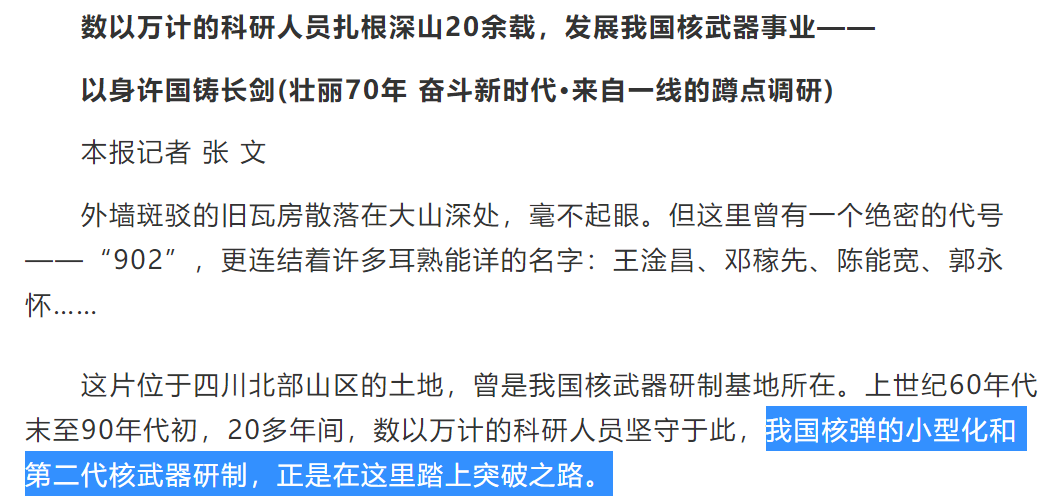














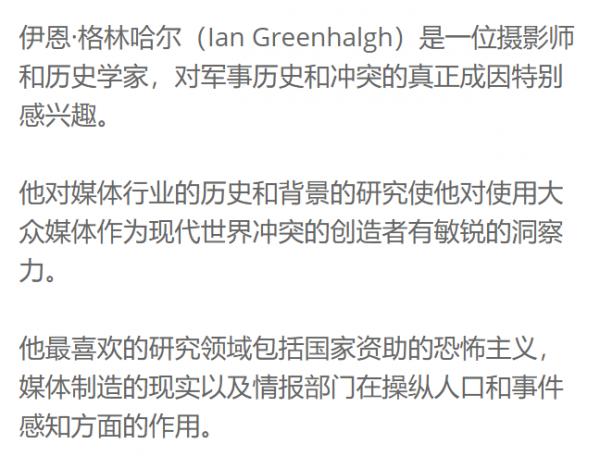


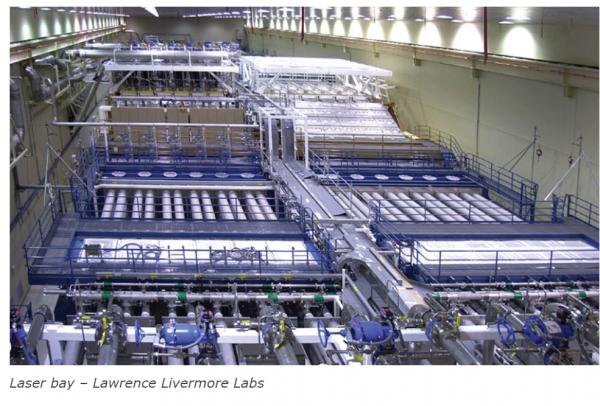
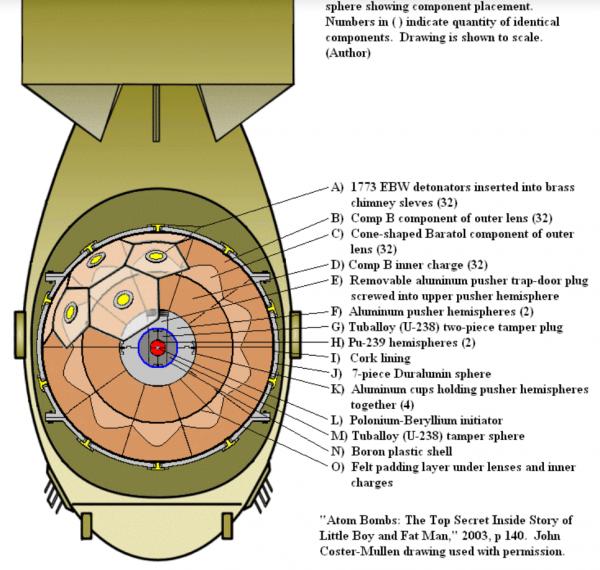
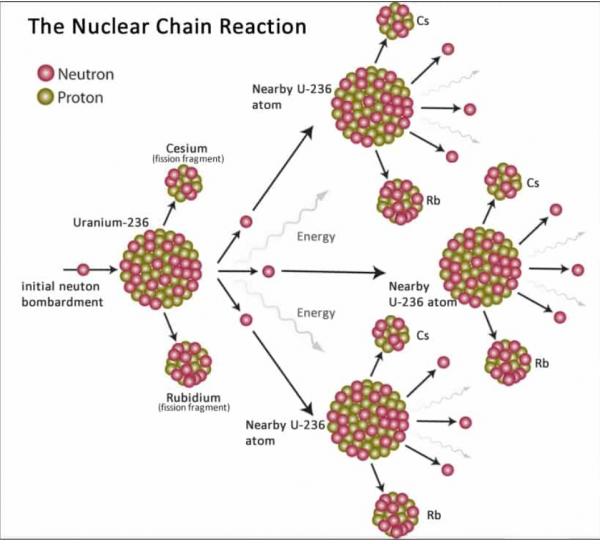

 ‘Fatman’ weapon being prepared for use on Tinian Island, August 1945.
‘Fatman’ weapon being prepared for use on Tinian Island, August 1945.